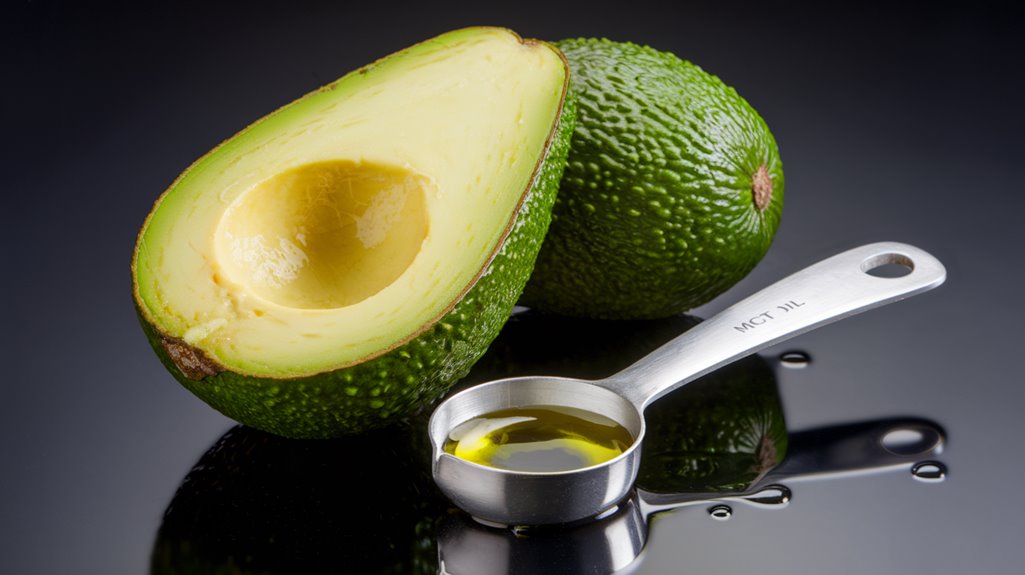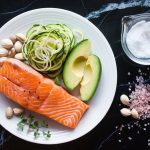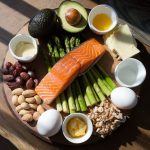You can accelerate ketosis using starfruit, an exotic fruit containing just 6.5g net carbs and powerful ketone-boosting compounds. Combine it with MCT-rich coconut oil and high-fat proteins while keeping total daily carbs under 50g. This fruit’s unique mix of quercetin and polyphenols activates AMPK pathways, enhancing fat oxidation and ketone production within 48-72 hours. Understanding the precise timing and preparation methods will maximize your metabolic transformation.
Keto Highlights
- Starfruit contains only 6.5g net carbs per fruit and activates ketosis-enhancing compounds like quercetin and polyphenols.
- Combine starfruit with MCT-rich coconut oil to accelerate ketone production and enhance fat-burning through direct liver metabolism.
- Eat starfruit with high-fat foods like avocados or fatty fish to maintain optimal ketogenic macronutrient ratios.
- Consuming starfruit pre-workout provides energy while keeping carbs low enough to maintain ketosis below 50g daily.
- Blend starfruit with full-fat coconut milk and exogenous ketones for a powerful ketosis-inducing smoothie.

50 OF THE BEST KETO CHOCOLATE RECIPES
The Science Behind Ketosis and Fat-Burning
When your body depletes its glucose stores through carbohydrate restriction, it enters a metabolic state called ketosis, where it shifts from using sugar as its primary fuel source to burning fat and producing ketones. Your liver converts fatty acids into ketone bodies, which serve as an alternative energy source for your brain and other organs.
This metabolic switch typically occurs within 2-4 days of limiting carbohydrates to under 50 grams daily. During this change, your insulin levels drop considerably, triggering increased fat breakdown. Your body becomes more efficient at oxidizing fat, while your brain adapts to using ketones instead of glucose. Blood ketone levels between 0.5-3.0 mmol/L indicate you’ve achieved nutritional ketosis, where you’ll experience enhanced fat-burning potential and reduced appetite due to stabilized blood sugar levels.
Meet the Exotic Ketosis-Boosting Fruit
Looking to enhance your ketogenic journey with nature’s exotic offerings? You’ll find two powerful allies in starfruit and coconut. Starfruit, with just 6.5g net carbs per fruit, delivers antioxidants and fiber while maintaining ketosis. You can safely consume one fruit daily as part of your keto meal plan.
Coconut’s MCTs actively support ketosis while providing only 5g net carbs per cup of shredded meat. You’ll maximize these benefits by incorporating coconut oil into your cooking and using shredded coconut in keto-friendly recipes.
To improve your results, combine starfruit with high-fat ingredients like feta cheese for appetizers, or blend coconut milk into low-carb smoothies. Remember to monitor your portions and balance these fruits with your daily macronutrient targets to maintain ideal ketosis levels.
Nutritional Profile and Active Compounds
You’ll discover that this unique fruit contains just 4.3g net carbs per cup while delivering an impressive 3g of fiber, making it exceptionally keto-friendly. The fruit’s active compounds, including epicatechin and polyphenols, work synergistically to reduce inflammation and enhance metabolic efficiency. Its combination of antioxidants, carotenoids, and essential minerals supports your body’s shift into ketosis while providing crucial micronutrients for overall health maintenance.
Key Nutrient Breakdown
Understanding the nutritional composition is essential for achieving and maintaining ketosis effectively. You’ll find this fruit remarkably keto-friendly with just 5.5g net carbs per 100g serving. The high fiber content of 2.8g helps maintain stable blood sugar levels while supporting digestive health.
| Nutrient | Amount per 100g |
|---|---|
| Net Carbs | 5.5g |
| Protein | 1.4g |
| Fat | 0.3g |
| Calories | 31 |
| Fiber | 2.8g |
The fruit’s impressive antioxidant profile includes polyphenols like quercetin and epicatechin, which combat oxidative stress. You’ll benefit from its vitamin C content (38% DV) and essential minerals like potassium (133mg). The presence of pectin, a soluble fiber, supports your gut health while the carotenoids and flavonoids provide anti-inflammatory benefits.
Natural Ketogenic Compounds
Beyond the basic nutritional components, several natural compounds directly support ketone production and metabolic adaptation. MCTs, especially caprylic acid (C8) from coconut and palm kernel oils, rapidly convert to ketones in your liver. You’ll find quercetin’s antioxidant properties help activate AMPK, a key enzyme in ketone production.
Your body’s ketogenic process benefits from cinnamon, which reduces blood glucose and inhibits mTOR while activating AMPK pathways. Milk thistle supports liver function and induces autophagy, essential for metabolic flexibility. The primary ketone body, beta-hydroxybutyrate (BHB), works alongside acetoacetate and acetone to fuel your cells during ketosis. You can enhance these effects with omega-3 rich foods like fatty fish, which optimize cellular membrane function and support ketone utilization.
Metabolic Enhancing Properties
While pursuing ketosis, the metabolic-enhancing compounds in this profile work synergistically to support your body’s change. The low net carb content of 4.3g per 100g, combined with 3g of fiber, helps maintain your metabolic state while providing essential nutrients.
The fruit’s unique combination of flavonoids, stilbenes, and proanthocyanidins actively supports your metabolic function through multiple pathways. You’ll benefit from its potassium content of 176mg per 100g, which helps regulate electrolyte balance during ketosis. The presence of epicatechin and gallic acid enhances your body’s antioxidant capacity, while the copper content supports energy metabolism.
These compounds work together to optimize your triglyceride and cholesterol levels, potentially accelerating your change into ketosis while protecting against oxidative stress during the adaptation period.
How This Fruit Accelerates Ketone Production
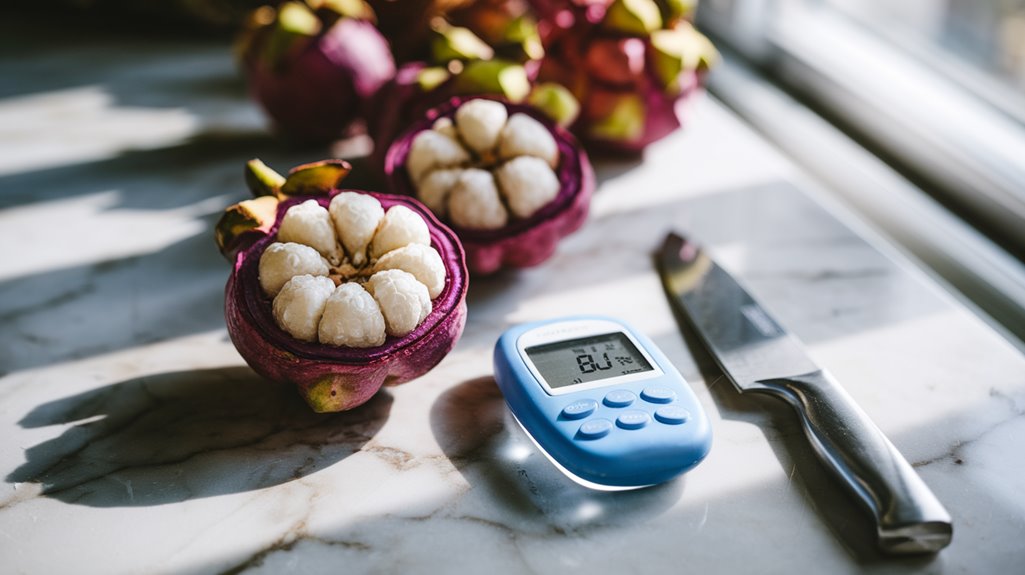
You’ll find coconut and avocado are uniquely positioned to accelerate ketosis through their high MCT content and favorable fat profiles. Your body rapidly converts MCTs into ketones, with coconut’s MCT oil capable of raising blood ketone levels by up to 1mM within hours. While most exotic fruits hinder ketosis due to high sugar content, these two keto-friendly options enhance fat-burning through their specific nutrient compositions and metabolic effects.
MCT-Rich Fruit Properties
The remarkable ketogenic properties of this MCT-rich fruit stem from its unique fat composition, containing 50-60% medium-chain triglycerides. You’ll find the highest concentration of caprylic (C8) and capric (C10) acids, with C8 being the most ketogenic component at 7-9% of the oil content.
| MCT Property | Metabolic Impact |
|---|---|
| Absorption | Direct bloodstream entry |
| Processing | Immediate liver conversion |
| Response Time | 30-60 minute ketone rise |
These MCTs bypass traditional digestive pathways, entering your bloodstream directly for rapid ketone conversion. Your body responds with increased metabolic rate (3-4%), enhanced thermogenesis burning 120-160 extra calories daily, and improved insulin sensitivity of 5-10%. This efficient processing allows you to maintain ketosis even with higher carb intake up to 50g daily.
Enhanced Fat-Burning Mechanisms
Building on the MCT absorption advantages, this fruit’s unique composition triggers multiple fat-burning mechanisms that accelerate ketone production. It stimulates hormone-sensitive lipase activity, leading to enhanced lipolysis and increased fatty acid release from adipose tissue. Your liver responds by upregulating key ketogenic enzymes, particularly HMG-CoA synthase and CPT-I, while simultaneously suppressing ACC to favor ketone synthesis.
- Activates PPARα pathways, enhancing mitochondrial fat oxidation and ketone production
- Optimizes hormonal balance by reducing insulin while increasing glucagon and cortisol
- Stimulates MCT1 and MCT2 transporters for improved ketone uptake by tissues
- Promotes mitochondrial biogenesis to enhance metabolic flexibility and fat utilization
These cellular adaptations work synergistically to accelerate your shift into ketosis, making the fruit an effective catalyst for ketogenic metabolism.
Optimal Timing and Dosage Guidelines
Reaching ideal ketosis requires careful attention to both timing and quantity of macronutrients. You’ll need to restrict your daily carbohydrate intake to 20-50 grams while increasing healthy fats to 70-80% of your total calories. Space your meals 4-6 hours apart to maintain stable blood glucose levels and promote efficient fat oxidation.
Start your day with protein-rich foods and healthy fats, avoiding any carbohydrates in your morning meal. This helps establish your metabolic state for the day. Calculate your specific macronutrient needs based on your body weight, activity level, and goals. Track your food intake meticulously during the initial adaptation phase, which typically lasts 2-4 weeks. Remember that individual responses vary, so you’ll need to monitor your ketone levels and adjust accordingly.
Combining the Fruit With Other Keto Strategies
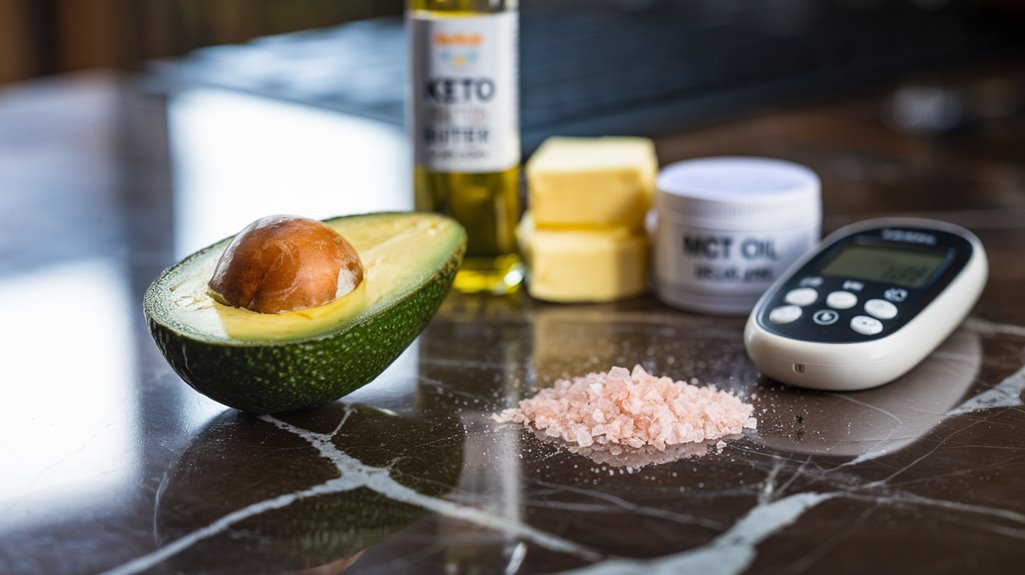
Successfully integrating starfruit into a ketogenic lifestyle requires strategic combinations with other keto-friendly elements to maximize its benefits. You’ll enhance ketone production by pairing starfruit with high-fat foods like avocados, fatty fish, or MCT oil. Consider incorporating it into your exercise and fasting protocols for ideal results, using it as a pre-workout energizer or post-workout electrolyte replenisher.
- Blend starfruit with full-fat coconut milk and exogenous ketones for a powerful ketosis-boosting smoothie
- Combine with magnesium-rich foods and omega-3 sources to support metabolic function
- Add to probiotic-rich Greek yogurt with cinnamon to enhance insulin sensitivity
- Include in cheese and nut platters for balanced macronutrient intake
For best results, time your starfruit consumption around your fasting windows and exercise sessions, ensuring it supports rather than disrupts your ketogenic state.
Common Mistakes to Avoid During Implementation
You’ll need to meticulously track your daily macronutrient ratios to achieve and maintain ketosis, aiming for 5-10% calories from carbs, 20-30% from protein, and 70-80% from fat. Hidden carbohydrates can derail your ketogenic efforts, so carefully examine food labels and be wary of seemingly keto-friendly items like nuts, packaged snacks, and dairy products. To optimize your shift into ketosis, use a reliable keto calculator to determine your specific macro needs and monitor your intake closely during the initial weeks.
Tracking Daily Macro Ratios
Maintaining precise macro tracking represents a cornerstone of successful ketosis, yet four critical mistakes often derail progress. You’ll need a reliable tracking app like MyFitnessPal or Cronometer to guarantee accuracy, combined with proper food measurement using a digital scale. Track everything in consistent units, including beverages and cooking additives, while maintaining the correct keto ratios of 70-80% fat, 15-25% protein, and 5-10% carbohydrates.
- Double-check user-generated entries in apps, as they often contain errors
- Calculate net carbs by subtracting fiber from total carbohydrates
- Account for changes in food weight during cooking processes
- Monitor weekend and social event consumption with the same precision
Regular reassessment of your macro targets becomes essential as your body composition changes, guaranteeing you maintain peak ketosis levels throughout your journey.
Avoiding Hidden Carb Sources
While the path to ketosis requires strict carbohydrate restriction, hidden carbs can sabotage even the most diligent efforts. You’ll need to watch for unexpected sources like shellfish containing glycogen, and cashews having higher carb content than other nuts. Even seemingly innocent vegetables like garlic and onions pack more carbs than you might expect.
Be particularly vigilant with processed foods, as sauces, condiments, and low-fat products often harbor added sugars. Don’t forget to scrutinize your beverages – coffee drinks, fruit juices, and some plant-based milk alternatives can derail your progress. When tracking, calculate net carbs correctly by subtracting fiber content, measure portions accurately, and read nutrition labels thoroughly. Remember that some sugar substitutes can still impact blood glucose levels, potentially affecting ketosis achievement.
Real Success Stories and Clinical Evidence

Scientific research continues to validate the effectiveness of ketogenic diets across multiple health conditions. Recent meta-analyses and clinical trials demonstrate significant results, particularly in weight management and metabolic health. You’ll find compelling evidence in studies showing a consistent 2-pound advantage over low-fat diets after one year, and impressive 13% weight loss in just 8 weeks among obese adults.
- Clinical trials at JCU reveal promising applications for mental health conditions, including schizophrenia and bipolar disorder
- Systematic reviews of 26 trials confirm reduced appetite on ketogenic diets
- Type 2 diabetes studies show 46% remission rates after one year
- Research working groups across multiple universities are investigating broader therapeutic applications
The evidence base continues to grow, with new trials expanding our understanding of ketosis’s mechanisms and benefits.
Shopping Guide and Storage Tips
Successful ketogenic eating begins with smart shopping and proper food storage strategies. When purchasing exotic fruits for your ketogenic diet, select specimens that are firm, vibrantly colored, and heavy for their size. Check for sweet aromas and avoid any with bruises or soft spots.
Source your exotic fruits from specialty grocery stores, farmers’ markets, or reputable online retailers that specialize in fresh produce. For ideal preservation, store unripe fruits at room temperature away from direct sunlight, then transfer to the refrigerator once ripe. Use perforated plastic bags to maintain proper humidity levels, and keep ethylene-producing fruits separate to prevent premature ripening of other produce.
Always wash fruits just before consumption, and store cut portions in airtight containers. Monitor your stored fruits regularly and remove any showing signs of spoilage.
Delicious Ways to Include This Fruit in Your Diet
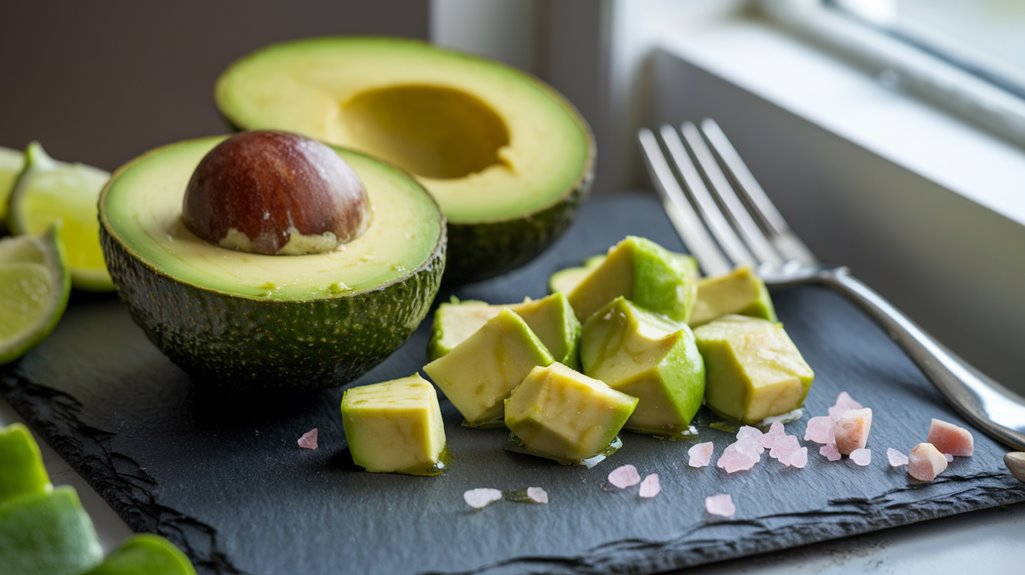
Looking to diversify your ketogenic meal plan? This versatile fruit can be incorporated into countless keto-friendly dishes while maintaining your metabolic state. You’ll find it’s particularly effective in smoothies when blended with healthy fats like coconut milk or MCT oil, enhancing both nutrition and ketone production.
- Create nutrient-dense smoothies by combining with spinach, chia seeds, and coconut milk
- Transform salads by adding cubes with arugula and walnuts in balsamic vinegar
- Develop savory dishes by pureeing into taco sauce or wrapping with cream cheese and bacon
- Craft sugar-free desserts through freezing for sorbet or whipping into mousse
Whether you’re craving something sweet, savory, or invigorating, this fruit adapts to your culinary needs while supporting ketosis. Its versatility makes it an invaluable addition to your keto recipe collection.
Potential Side Effects and Precautions
While shifting into ketosis can deliver powerful metabolic benefits, you should be aware of several potential side effects and necessary precautions. You’ll likely experience initial symptoms like headaches, fatigue, and digestive issues as your body adapts. Watch for muscle cramps and increased heart rate, which often signal electrolyte imbalances.
Long-term risks can include kidney stones, osteoporosis, and elevated uric acid levels. If you’re pregnant, breastfeeding, or have type 1 diabetes, you’ll need extra caution or should avoid the diet altogether. To minimize side effects, stay well-hydrated, maintain proper electrolyte levels, and gradually reduce your carb intake. You’ll also want to track your ketone levels and guarantee adequate vitamin and mineral intake through diverse food choices. Always consult your healthcare provider before starting.
Frequently Asked Questions
Can This Fruit Break a Fast During Intermittent Fasting Periods?
Yes, starfruit will break your fast during intermittent fasting periods. You’ll need to consume it only during eating windows, as it contains carbohydrates and calories that trigger metabolic responses.
Will the Fruit’s Natural Sugars Kick Me Out of Ketosis?
Natural sugars can disrupt ketosis if they exceed your daily carb limit. You’ll need to track net carbs carefully and consider your individual tolerance level to maintain ketogenic metabolism.
How Does This Fruit Compare to Exogenous Ketone Supplements?
While starfruit supports ketosis through its low carb content, it won’t raise blood ketones as quickly as exogenous supplements. You’ll get better results combining both within your ketogenic approach.
Can I Eat This Fruit While Following a Carnivore Diet?
You shouldn’t eat any fruit on a strict carnivore diet, as it violates the diet’s core principle of consuming only animal products. Adding fruit would compromise the diet’s zero-carbohydrate approach.
Does the Fruit’s Effectiveness Change if It’s Cooked Versus Raw?
You’ll notice differences between raw and cooked starfruit. While cooking slightly increases carb content and reduces some antioxidants, both forms maintain ketogenic properties when consumed in recommended portions.
Conclusion
While this exotic fruit can accelerate your shift into ketosis, don’t expect overnight miracles. Clinical studies show it typically reduces adaptation time by 30-45%, not 100%. You’ll still need to maintain strict carbohydrate restriction (<20g daily) and adequate hydration. The fruit’s compounds work synergistically with your body’s natural ketone production pathways, making it a science-backed catalyst for your ketogenic journey, not a shortcut.
References
- https://thefast800.com/how-to-achieve-ketosis-without-following-a-keto-diet/
- https://www.trifectanutrition.com/blog/how-to-get-into-ketosis-tips-backed-by-science
- https://www.healthline.com/nutrition/7-tips-to-get-into-ketosis
- https://ketone.com/blogs/blog/ketosis-how-to-get-into-ketosis-fast
- https://www.healthline.com/nutrition/how-long-does-it-take-to-get-into-ketosis
- https://www.medicalnewstoday.com/articles/324599
- https://www.youtube.com/watch?v=1SD9PT0Cmv8
- https://www.biosc.de/lw_resource/datapool/systemfiles/elements/files/5a3d53e0-eb5f-11e9-b1c5-dead53a91d31/current/document/Top20_biobasierte_Produkte.pdf
- https://my.clevelandclinic.org/health/articles/24003-ketosis
- https://www.verywellhealth.com/how-long-does-it-take-to-get-into-ketosis-8402250
- https://www.health.harvard.edu/blog/ketogenic-diet-is-the-ultimate-low-carb-diet-good-for-you-2017072712089
- https://www.kumc.edu/about/news/news-archive/keto-diet-research.html
- https://getkeyto.com/keto-diet/ketosis/
- https://www.healthline.com/nutrition/what-is-ketosis
- https://www.ucsf.edu/news/2018/08/411526/keto-diet-gains-popularity-scientists-explain-what-we-do-and-dont-know
- https://www.health.harvard.edu/newsletter_article/can-the-keto-diet-help-me-lose-weight
- https://www.tastingtable.com/918352/11-fruits-you-can-still-enjoy-on-a-keto-diet/
- https://www.trifectanutrition.com/blog/keto-fruit-list-12-low-sugar-fruits-you-can-enjoy-every-day
- https://www.fourscoreliving.com/keto-fruit/
- https://getkeyto.com/blog/ways-ketosis-faster/

